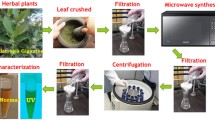Abstract
Carbon quantum dots (CQDs) exhibit tremendous advantages for plant growth study due to its strong fluorescence and good biocompatibility. The fluorescent CQDs were synthesized by the one-step microwave method with the raw materials of citric acid (CA) and urea (UR), and expressed a unique green fluorescence with the optimal excitation wavelength of over 400 nm through adjusting the doping of N elements. It is demonstrated that CQDs can act as deliver media in plant and fluorescent probes for plant cell imaging through directly cultivated in the seedlings of melon and wheat, respectively. Based on the effects of the fluorescent CQDs on plants growth, we can further study the mechanisms of the ions transport in plants.
Similar content being viewed by others
References
Ju H. Sensitive Biosensing Strategy based on Functional Nanomaterials [J]. Science China Chemistry, 2011, 54(8): 1 202–1 217
Zheng L, Hong F, Lu S, et al. Effect of Nano–TiO2 on Strength of Naturally Aged Seeds and Growth of Spinach[J]. Biological Trace Element Research, 2005, 104(1): 83–91
Yiu HHP Pickard MR, Olariu CI, et al. Fe3O4–PEI–RITC Magnetic Nanoparticles with Imaging and Gene Transfer Capability: Development of a Tool for Neural Cell Transplantation Therapies[J]. Pharmaceutical Research, 2011, 29(5): 1 328–1 343
Aguilera–Sigalat J, Bradshaw D. Synthesis and Applications of Metal–organic Framework–quantum Dot (QD@MOF) Composites[J]. Coordination Chemistry Reviews, 2016, 307: 267–291
Ding L, Zhang B, Xu C, et al. Fluorescent Glucose Sensing Using CdTe/CdS Quantum Dots–glucose Oxidase Complex[J]. Anal. Methods, 2016, 8(14): 2 967–2 970
Gao F, Ma S, Li J, et al. Rational Design of High Quality Citric Acid–derived Carbon Dots by Selecting Efficient Chemical Structure Motifs [J]. Carbon, 2017, 112: 131–141
Gong X, Lu W, Liu Y, et al. Low Temperature Synthesis of Phosphorous and Nitrogen co–doped Yellow Fluorescent Carbon Dots for Sensing and Bioimaging[J]. Journal of Materials Chemistry B, 2015, 3(33): 6 813–6 819
Chen Q, Wang C, Chen S. One–step Synthesis of Yellow–emitting Carbogenic Dots toward White Light–emitting Diodes[J]. Journal of Materials Science, 2013, 48(6): 2 352–2 357
Konwar A, Gogoi N, Majumdar G, et al. Green Chitosan–carbon Dots Nanocomposite Hydrogel Film with Superior Properties[J]. Carbohydrate Polymers, 2015, 115: 238–245
Kasibabu BSB, DSouza SL, Jha S, et al. Imaging of Bacterial and Fungal Cells Using Fluorescent Carbon Dots Prepared from Carica papaya Juice[J]. Journal of Fluorescence, 2015, 25(4): 803–810
Li X, Wang H, Shimizu Y, et al. Preparation of Carbon Quantum Dots with Tunable Photoluminescence by Rapid Laser Passivation in Ordinary Organic Solvents[J]. Chemical Communications (Cambridge, England), 2010, 47(3): 932–934
Li L, Ji J, Fei R, et al. A Facile Microwave Avenue to Electrochemiluminescent Two–Color Graphene Quantum Dots[J]. Advanced Functional Materials, 2012, 22(14): 2 971–2 979
Kang W, Ding Y, Zhou H, et al. Monitoring the Activity and Inhibition of Alkaline Phosphatase via Quenching and Restoration of the Fluorescence of Carbon Dots[J]. Microchimica Acta, 2015, 182(5–6): 1 161–1 167
Yang X, Zhuo Y, Zhu S, et al. Novel and Green Synthesis of High–fluorescent Carbon Dots Originated from Honey for Sensing and Imaging [J]. Biosensors and Bioelectronics, 2014, 60: 292–298
Bhaisare ML, Talib A, Khan MS, et al. Synthesis of Fluorescent Carbon Dots via Microwave Carbonization of Citric Acid in Presence of Tetraoctylammonium Ion, and Their Application to Cellular Bioimaging [J]. Microchimica Acta, 2015, 182(13–14): 2 173–2 181
Zhou X, Li Z, LI Z. Fabrication of Valine–functionalized Graphene Quantum Dots and Its Use as a Novel Optical Probe for Sensitive and Selective Detection of Hg 2+[J]. Spectrochimica Acta Part A: Molecular and Biomolecular Spectroscopy, 2017, 171: 415–424
Yu J, Song N, Zhang Y, et al. Green Preparation of Carbon Dots by Jinhua Bergamot for Sensitive and Selective Fluorescent Detection of Hg2+ and Fe3+[J]. Sensors and Actuators B: Chemical, 2015, 214: 29–35
Namdari P, Negahdari B, Eatemadi A. Synthesis, Properties and Biomedical Applications of Carbon–based Quantum Dots: An Updated Review[J]. Biomedicine & Pharmacotherapy, 2017, 87: 209–222
Ding C, Zhu A, Tian Y. Functional Surface Engineering of C–Dots for Fluorescent Biosensing and in vivo Bioimaging[J]. Accounts of Chemical Research, 2013, 47(1): 20–30
Author information
Authors and Affiliations
Corresponding author
Additional information
Funded by the National Natural Science Foundation of China (Nos. 61575150 and 61377092) and the Fundamental Research Funds for the Central Universities (WUT: 2017II46GX)
Rights and permissions
About this article
Cite this article
Ding, L., Wang, X., Li, J. et al. Synthesis of Fluorescent Carbon Quantum Dots and Their Application in the Plant Cell Imaging. J. Wuhan Univ. Technol.-Mat. Sci. Edit. 33, 1546–1550 (2018). https://doi.org/10.1007/s11595-018-2004-8
Received:
Accepted:
Published:
Issue Date:
DOI: https://doi.org/10.1007/s11595-018-2004-8




